Lophotrochozoa - Study guides, Revision notes & Summaries
Looking for the best study guides, study notes and summaries about Lophotrochozoa? On this page you'll find 43 study documents about Lophotrochozoa.
Page 3 out of 43 results
Sort by
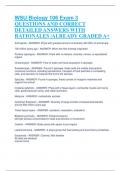
-
WSU Biology 106 Exam 3 QUESTIONS AND CORRECT DETAILED ANSWERS WITH RATIONALES |ALREADY GRADED A+
- Exam (elaborations) • 14 pages • 2024
- Available in package deal
-
- £10.37
- + learn more
WSU Biology 106 Exam 3 QUESTIONS AND CORRECT DETAILED ANSWERS WITH RATIONALES |ALREADY GRADED A+ Arthropods - ANSWER- Phyla with greatest amount of diversity with 85% of animal spp 700 million years ago - ANSWER- When the first animals originated Porifera (sponges) - ANSWER- Phyla with no tissues, muscles, nerves, or specialized organs Choanocytes - ANSWER- Flow of water and food acquisition in sponges Amoebocytes - ANSWER- Found in sponges, these cells are mobile and perform numer...
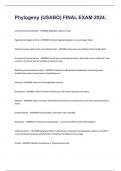
-
Phylogeny (USABO) FINAL EXAM QUESTIONS 2024.
- Exam (elaborations) • 4 pages • 2024
- Available in package deal
-
- £8.77
- + learn more
Phylogeny (USABO) FINAL EXAM QUESTIONS 2024. Chytridiomycota (chytrids) - ANSWER flagellated spores; fungi Zygomycota (zygomycetes) - ANSWER resistant zygosporangium as sexual stage; fungi Glomeromycota (arbuscular mycorrhizal fungi) - ANSWER arbuscular mycorrhizae formed with plants Ascomycota (ascomycetes) - ANSWER sexual spores (ascospores) borne internally in sacs called asci; vast numbers of asexual spores (conidia) produced; fungi Basidiomycota (basidiomycetes) - ANSWER elabo...
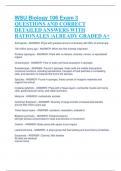
-
WSU Biology 106 Exam 3 QUESTIONS AND CORRECT DETAILED ANSWERS WITH RATIONALES |ALREADY GRADED A+
- Exam (elaborations) • 14 pages • 2023
- Available in package deal
-
- £10.37
- + learn more
WSU Biology 106 Exam 3 QUESTIONS AND CORRECT DETAILED ANSWERS WITH RATIONALES |ALREADY GRADED A+ Arthropods - ANSWER- Phyla with greatest amount of diversity with 85% of animal spp 700 million years ago - ANSWER- When the first animals originated Porifera (sponges) - ANSWER- Phyla with no tissues, muscles, nerves, or specialized organs Choanocytes - ANSWER- Flow of water and food acquisition in sponges Amoebocytes - ANSWER- Found in sponges, these cells are mobile and perform nume...
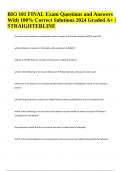
-
BIO 101 FINAL Exam Questions and Answers With 100% Correct Solutions 2024 Graded A+ | STRAIGHTERLINE
- Exam (elaborations) • 21 pages • 2024
-
- £14.75
- + learn more
BIO 101 FINAL Exam Questions and Answers With 100% Correct Solutions 2024 Graded A+ | STRAIGHTERLINE. the calvin cycle reactions are dependent upon a supply of carbon dioxide, NADPH, and ATP which cofactor is involved in the Calvin cycle reactions? NADP+ segments of DNA that are not part of the gene are called introns which of the following is not true of ribosomes they bind only one type of amino acid which part of an operon is incorrectly matched with its function? regulator--binds to the ...
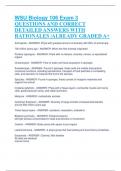
-
WSU Biology 106 Exam 3 QUESTIONS AND CORRECT DETAILED ANSWERS WITH RATIONALES |ALREADY GRADED A+
- Exam (elaborations) • 14 pages • 2023
- Available in package deal
-
- £9.57
- + learn more
WSU Biology 106 Exam 3 QUESTIONS AND CORRECT DETAILED ANSWERS WITH RATIONALES |ALREADY GRADED A+ Arthropods - ANSWER- Phyla with greatest amount of diversity with 85% of animal spp 700 million years ago - ANSWER- When the first animals originated Porifera (sponges) - ANSWER- Phyla with no tissues, muscles, nerves, or specialized organs Choanocytes - ANSWER- Flow of water and food acquisition in sponges Amoebocytes - ANSWER- Found in sponges, these cells are mobile and perform numer...
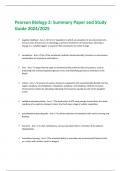
-
Pearson Biology 2: Summary Paper and Study Guide 2024/2025
- Exam (elaborations) • 11 pages • 2024
-
- £2.39
- + learn more
negative feedback - AnsA form of regulation in which accumulation of an end product of a process slows the process; in physiology, a primary mechanism of homeostasis, whereby a change in a variable triggers a response that counteracts the initial change. cerebellum - AnsPart of the vertebrate hindbrain located dorsally; functions in unconscious coordination of movement and balance. liver - AnsA large internal organ in vertebrates that performs diverse functions, such as producing bi...
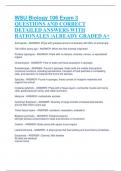
-
WSU Biology 106 Exam 3 QUESTIONS AND CORRECT DETAILED ANSWERS WITH RATIONALES |ALREADY GRADED A+
- Exam (elaborations) • 14 pages • 2024
-
- £9.17
- + learn more
WSU Biology 106 Exam 3 QUESTIONS AND CORRECT DETAILED ANSWERS WITH RATIONALES |ALREADY GRADED A+ Arthropods - ANSWER- Phyla with greatest amount of diversity with 85% of animal spp 700 million years ago - ANSWER- When the first animals originated Porifera (sponges) - ANSWER- Phyla with no tissues, muscles, nerves, or specialized organs Choanocytes - ANSWER- Flow of water and food acquisition in sponges Amoebocytes - ANSWER- Found in sponges, these cells are mobile and perform numerous ...
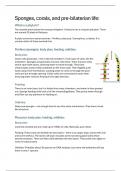
-
Hilary term: Diversity of Life lecture notes
- Lecture notes • 113 pages • 2024
- Available in package deal
-
- £16.66
- + learn more
Contains the following lectures 1. Sponges, corals, and pre-bilaterian life: 2. Bilateria & bilaterian phylogeny: 3. Lophotrochozoa I: Annelids 4. Lophotrochozoa II: Platyhelminthes (flatworms) 5. Lophotrochozoa III: Molluscs 6. Ecdysozoa I: 7. Deuterostomia I: Echinoderms & Hemichordates 8. Deuterostomia II: Chordates 9. What is a plant? 10. The Rise of the Vascular Plants 11. The Diversification of Seed Plants: 12. The Evolution of Flowering Plants: 13. Arthropods I: Chelicerates...
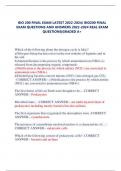
-
BIO 200 UPDATED FINAL EXAM LATEST 2023-2024/ BIO200 FINAL EXAM QUESTIONS AND ANSWERS 2023-2024 REAL EXAM QUESTIONS|A+ GUARANTEED
- Exam (elaborations) • 23 pages • 2023
-
- £6.77
- + learn more
The advantage of yeast cells over bacterial cells to express human proteins is that: -CORRECT ANSWER-- yeast cells are eukaryotic and modify proteins similarly to human cells Which of the following is a change that might have facilitated the move of aquatic plants onto land? a) desire for protection from herbivory b) protection from desiccation c) ability to survive with lower [CO2] d) adaptation to seasons e) ability to grow tall -CORRECT ANSWER-- ability to survive with lower CO2 Br...
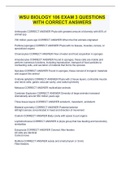
-
WSU BIOLOGY 106 EXAM 3 QUESTIONS WITH CORRECT ANSWERS
- Exam (elaborations) • 15 pages • 2023
-
- £7.97
- + learn more
Arthropods CORRECT ANSWER Phyla with greatest amount of diversity with 85% of animal spp 700 million years ago CORRECT ANSWER When the first animals originated Porifera (sponges) CORRECT ANSWER Phyla with no tissues, muscles, nerves, or specialized organs Choanocytes CORRECT ANSWER Flow of water and food acquisition in sponges Amoebocytes CORRECT ANSWER Found in sponges, these cells are mobile and perform numerous functions, including reproduction, transport of food particles to nonf...

That summary you just bought made someone very happy. Also get paid weekly? Sell your revision notes on Stuvia! Discover all about earning on Stuvia


